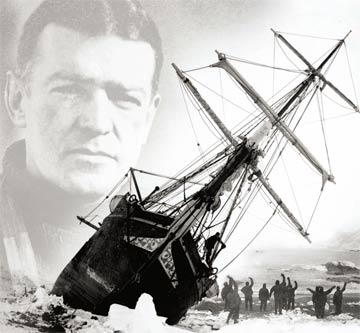Successfully Leading People Through Crisis, Stress, Fear, Anxiety, & Chaos
As a leader, you willinevitably find yourself having to navigate your team through uncertainty, anxiety, stress, fear, and chaos. Perhaps a full-blown, real crisis. There's no secret formula or magic recipe; the fundamental principles of leadership remain the same whether through crisis or everyday routines. Here's story of just such an extraordinary event, and some practical application actions that you can take in any situation to help your team not just urvive, but thrive.
Ernest Shackleton, British explorer, early 1900's, embarks on a voyage to Antarctica in the aptly named ship "Endurance." After stopping to refresh and refuel at a whaling station on South Georgia Island in the southern Atlantic Ocean, Shackleton and his crew chart a course for Antarctica, entering the treacherous, ice-filled Weddell Sea. The relentless and unforgiving ice crushes the hull of the ship, causing it to sink to the bottom and leaving the crew of twenty-eight men stranded on an ice-flow - some 10,000 miles from home.
They had salvaged three lifeboats from the ship, each about twenty-feet long and weighing a thousand pounds apiece, which they proceed to drag across 500 miles of ice, averaging just three to five miles a day, seven days a week, over a period of more than five months. Down to one cup of milk per day per man and thoroughly exhausted, they launch the lifeboats, man the oars, and hope to reach the safety of Elephant Island, the southern-most inhabitable island in the southern Atlantic Ocean. After initially rowing in the wrong direction due to heavy cloud cover and ending up thirty miles behind where they started, they start rowing again and finally, miraculously, beach the boats on Elephant Island.
Twenty-two men stay behind, and six men, including Shackleton, rig a make-shift mast on one of the lifeboats and sail off for South Georgia Island - over 800 miles away in the churning, turbulent Southern Atlantic Ocean, in that twenty-foot-long open boat. Remarkably they make it, but land on the wrong side of the island in the midst of a hurricane-force storm which destroys the lifeboat. Three men stay behind with the remnants of it, and the three others including Shackleton trek across thirty-two miles of the snow-and-ice covered 9,000 foot peaks of South Georgia to get back to the whaling station and safety. They then collect their three comrades on the other side of that island and mount a rescue to return to Elephant Island and recover the twenty-two men waiting there. Frustratingly, that rescue is delayed an additional four months due to an unexpected winter storm.
Back again they all sail to South Georgia, and finally back to England, two-and-a-half years after they had started. Shackleton left England with twenty-eight men ...and returned with twenty-eight men. It's often referred to as one of the most extraordinary survival stories in history.
If you have a little extra time to read these days, the book you want is called "Leading at the Edge" by Dennis N.T. Perkins, retired Marine captain. The question Perkins digs into is "How did Shackleton get them back safely, living at the very edge of death month after month after month? Here are a few thoughts from Perkins' book that may be useful for you as a leader in times of crisis, chaos, fear, anxiety, and stress:

- He built structure and routine, creating order out of chaos. He understood the stabilizing role of structure.
- He directed negative energy to activity, knowing that activity reduces anxiety.
- He didn't focus on the circumstances, but created vision, knowing that without vision, people will wander aimlessly. Energy comes from purpose.
- He maintained constant visibility, full engagement with the men, and an attentive presence, which together are the leader's source of energy.
- He knew that being positive is a force-multiplier - the perceived attitude of the leader can create fear or confidence in the people.
- He subordinated his own well-being to his men. Leaders eat last.
- He constantly emphasized that "our only hope lies in our unity."
- He believed obstacles only exist in the universe in order for us to figure out how to overcome them.
It seems fitting that he named the ship "Endurance." It's from the Shackleton family motto, going back generations, which was: "By endurance we conquer."
I hope you find his remarkable story helpful during difficult times; perhaps it will help you in leading your team through turbulence and chaos.
